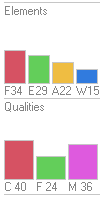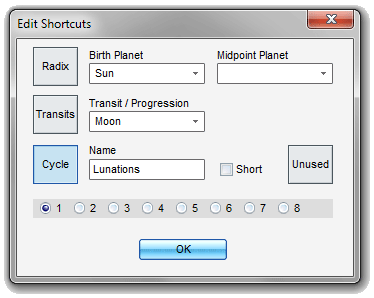
| What Watch? - Tutorial | Next chapter: FAQ 1 - General Questions | Back to First Page |
Customize What Watch
Every astrologer has his preferences for certain techniques, certain planets, certain traditions. On its "preferences" tab, What Watch offers a choice of variations to accomodate for this. And you can define your own shortcuts to favourite constellations that What Watch will calculate with the click of a single button.
 |
On the "preferences" tab, you can choose the house system that What Watch will use for all house calculations (Placidus, Koch, Regiomontanus, Campanus, Porphyry or Equal). You can select whether the centaurs Pholus, Nessus and Asbolus are displayed in the chart graphics, whether Quaoar, Sedna, Ceres or Lilith are included. Another important customization is to determine the planets' weight, that will be used for calculating element and quality balances. What Watch comes with default values that reflect my personal experience. Yours may be different. For example, I've included the biggest asteroid Ceres, with a weight of two percent. Please keep in mind that you should always use planet weights that add up to 100 so that you can interpret the resulting sums as percentage values. |
You can select whether you want the zodiac in chart wheels drawn in color or black and white. And, you can determine the orbs used for different aspect groups.
All selections revert to startup values when you close What Watch unless you explicitly save them for later use (by using the "save" button on the "preferences" tab).
For calculations that you need very often, you can define shortcuts. A shortcut is a set of planets and a calculation that you can predefine and that will execute on the click of a single button. For example, if you are frequently looking at the transits of Uranus over Mars in a whole set of charts, you can define this transit as a shortcut to have rapid access to this particular constellation.
Shortcuts are located on the top panel of What Watch. There is a set of shortcuts predefined when you start What Watch for the first time, but you can freely edit all of them by clicking the "Edit Shortcuts" button on the "preferences" tab, that will activate the dialog shown below.
|
You have the same choices here as on the top panel. You can choose a birth planet, a midpoint planet and a transiting planet. On the left, there are three buttons that represent calculations: radix, transit lists and cycle lists (mundane). If you click on the "short" button, transit lists will only show conjunctions, improving the rendering, among others, of solar return lists. You can give each shortcut a name. With the radio buttons below, you can choose which of the eight possible shortcuts to use. There is a default for every shortcut that you can change as you like. |  |
The example above shows a shortcut to calculate lunations: the cycle of Sun and Moon, independent from a birthchart.
| What Watch? - Tutorial | Next chapter: FAQ 1 - General Questions | Back to First Page |